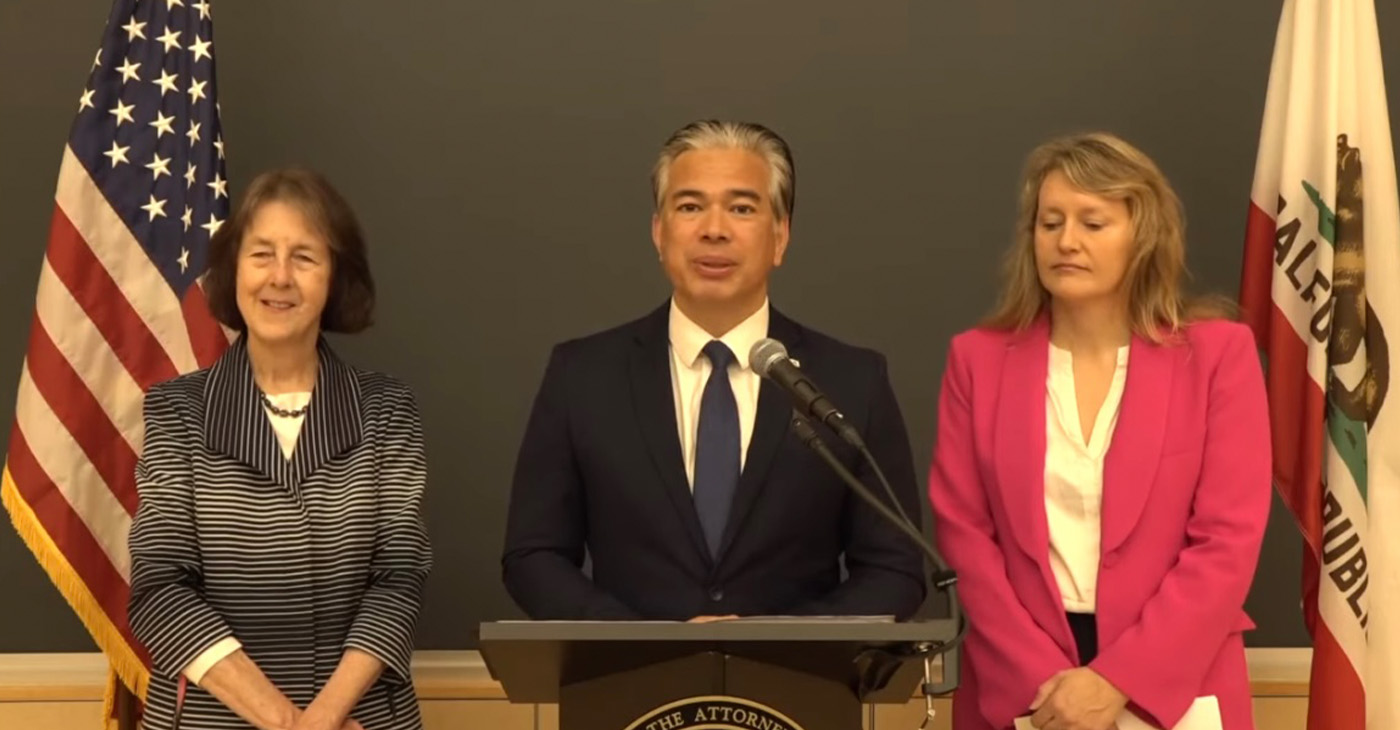Technology
Google is Starting Small, Thinking Big with ‘Project Fi’

In this April 24, 2015 photo, Nick Fox, Vice President for Communications Products at Google, prepares a presentation on Project Fi, in Mountain View, Calif. Project Fi is Google’s recently launched attempt to usher in new ways to keep smartphones online while lowering the cost for streaming video, listening to music, getting directions and searching for information. (AP Photo/Marcio Jose Sanchez)
MICHAEL LIEDTKE, AP Technology Writer
MOUNTAIN VIEW, Calif. (AP) — Google wants the wireless services that connect mobile devices to digital content to be cheaper and more reliable.
The reason has as much to do with the pursuit of profit as with trying to make smartphones more useful. More time spent using Google’s dominant search engine or watching videos on its popular YouTube site translates into more opportunities for the company to show its moneymaking ads.
Enter “Project Fi,” the Internet company’s recently launched attempt to usher in new ways to keep smartphones online while lowering the cost for streaming video, listening to music, getting directions and searching for information.
“Wireless connectivity has become so essential that it’s kind of like our lifeblood,” says Nick Fox, the Google Inc. executive overseeing Project Fi. “This gives us a playground where we can try things out.”
In a break from the status quo, Project Fi will cost just $20 for basic service and then only charge for the amount of data consumed over cellular networks that Google is leasing from T-Mobile and Sprint. Most plans charge a flat rate under metered plans that limit customers to a specific amount of data.
Google’s service is also promising to automatically switch customers to publicly available Wi-Fi networks to avoid incurring charges for using data on the cellular networks.
Here are some key things to know about Project Fi culled from a recent interview with Fox at Google’s Mountain View, California, headquarters.
___
STARTING SMALL, THINKING BIG
Although Fox wouldn’t disclose how many customers Project Fi will accept, it’s clearly going to be a relatively small pool of U.S. consumers at the outset. Getting on the wireless service requires a Nexus 6 smartphone, a model made by Motorola for Google as a showcase for how it would like its services to work with its Android operating system. Nexus 6 owners also need an invitation to subscribe to Project Fi (requests for invitation can be made here: https://fi.google.com/signup).
Google, though, is hoping Project Fi reshapes the market. If some of its technological features work well, Google will implant them into future updates of Android so they are available on the hundreds of millions of other devices running on the software, Fox said.
After spending more than two years developing Project Fi, Google is also counting on other wireless carriers copying its ideas, particularly on pricing.
“We are focused more on Android where we can have the most influence, but to the extent that the ideas take off and go broader than Project Fi, that’s great for users,” Fox said.
Google ultimately just wants people to spend more of their lives online because when that happens, it brings more traffic to its search engine, YouTube and other services such as Gmail and maps.
___
BILLING BY MEGABYTE
Google’s pricing system seems the feature most likely to shake up the wireless market. Project Fi only charges subscribers for the precise amount of cellular data used, an approach that Google came up with after its internal studies concluded most people consume less than 2 gigabytes a month yet often pay for much higher limits.
The solution: Project Fi subscribers will pay just a penny per megabyte of cellular data. That means 501 megabytes — a little over half a gigabyte — would cost just $5.01 even if a Project Fi user had signed up for a 2 gigabyte monthly plan listed at $20.
___
SEAMLESS WI-FI
Google knows a lot about the strength of public Wi-Fi networks because it gathers the information when people connect to it services. Project Fi is relying on this intelligence to automatically switch its users from a cellular tower to a free Wi-Fi system with a signal strong enough to stream video and music, another effort to save people money
This could mean a smartphone will shift to a Wi-Fi network downloading at 10 megabits, even if a T-Mobile or Sprint network is available at 30 megabits, Fox said, because the slower speed is still strong enough for a solid connection.
The Wi-Fi switch won’t automatically occur, though, on free networks in businesses and airports that require a user to accept terms of service or perform some manual acknowledgement.
In an effort to protect passwords and personal data, Project Fi creates a private transmission channel while its subscribers are using a publicly accessible Wi-Fi system.
____
BRIDGING DEVICES
Project Fi will store subscriber phone numbers in Google data centers so that they may be accessed on other devices besides smartphones. That means a Project Fi user will be able to send and receive texts, or make or receive calls, on their personal computers, tablets or even other smartphones besides their own, as long as they logged in.
____
NETWORK JUMPING
Project Fi also is promising to automatically decide whether its subscribers are better off on either T-Mobile’s or Sprint’s cell network, no matter where they are. Google developed an identification, or SIM, card that can store 10 different network profiles to make it possible to toggle between networks run by two different carriers.
Copyright 2015 The Associated Press. All rights reserved. This material may not be published, broadcast, rewritten or redistributed.
Community
Attorney General Rob Bonta, Oakland Lawmakers, Introduce Legislation to Protect Youth Online
At a press conference in downtown Oakland on Jan. 29, Attorney General Rob Bonta joined Sen. Nancy Skinner (D-Berkeley) and Assemblymember Buffy Wicks (D-Oakland) to announce two pieces of legislation designed to protect children online. The bills are Senate Bill (SB) 976, the Protecting Youth from Social Media Addiction Act and Assembly Bill (AB) 1949, the California Children’s Data Privacy Act.

By Magaly Muñoz
At a press conference in downtown Oakland on Jan. 29, Attorney General Rob Bonta joined Sen. Nancy Skinner (D-Berkeley) and Assemblymember Buffy Wicks (D-Oakland) to announce two pieces of legislation designed to protect children online.
The bills are Senate Bill (SB) 976, the Protecting Youth from Social Media Addiction Act and Assembly Bill (AB) 1949, the California Children’s Data Privacy Act.
Skinner authored SB 976, which addresses online addiction affecting teenage users, while Wicks’s bill, AB 1949, takes on big tech by proposing data privacy and children rights protections.
“Social media companies unfortunately show us time and time again that they are all too willing to ignore the detriment to our children, the pain to our children, the mental health and physical challenges they face, in order to pursue profits,” Bonta said.
SB 976 would allow parents to control the nature and frequency of the content their under-18-year-old children see on social media. Notifications from social media platforms would also be paused from midnight to 6 am and controls would allow parents to set time limits on their children’s usage based on their discretion.
Skinner stated that the longer that kids are on their phones during the day, the higher the risk for depression, anxiety and other related issues.
The bill would also push to get rid of addictive media that is harmful for young women and girls, specifically image filters that mimic cosmetic plastic surgery.
Bonta and 33 other attorney generals had previously filed a lawsuit against Meta, owner of the popular social media applications Instagram and Facebook. The filing claims that the company purposefully uses algorithmized content that harms younger audiences.
“Social media companies have the ability to protect our kids, they could act, but they do not,” Skinner said.
The Child Data Privacy Act would strengthen existing protections for data privacy under the California Consumer Privacy Act (CCPA). The lawmakers argue that the law does not have effective protection for those under 18 years old.
Wicks stated that the bill would forbid businesses from collecting, using, sharing, or selling personal data of anyone underage unless they receive informed consent, or it becomes necessary for the purpose of the business.
Wicks added that the acts would make it so that a search on the internet like “How do I lose weight?” would not result in dieting pill advertisements targeting youth, which, some experts report, could be harmful to their mental and physical health.
“In a digital age where the vulnerabilities of young users are continually exploited, we cannot afford to let our laws lag behind, our children deserve complete assurance that their online experience will be safeguarded from invasive practices,” Wicks said.
Supporters of the two acts say they have gained bipartisan support issue, but the authors and Bonta expect them to be met with pushback from the affected companies.
#NNPA BlackPress
Unleashing the Power_ Discover the The Thrills…F-TYPE Convertible
Performance & Handling Powered by a robust 5.0 Liter Supercharged 8 Cylinder Gas Engine, the F-Type R75 doesn’t just purr; it roars with a mighty 575 horsepower and 516 lb-ft of torque. Coupled with an 8-speed Automatic Transmission, the car offers an exhilarating drive that is both fast and smooth. The All-Wheel Drive system ensures […]
The post Unleashing the Power_ Discover the The Thrills…F-TYPE Convertible first appeared on BlackPressUSA.

Performance & Handling
Powered by a robust 5.0 Liter Supercharged 8 Cylinder Gas Engine, the F-Type R75 doesn’t just purr; it roars with a mighty 575 horsepower and 516 lb-ft of torque. Coupled with an 8-speed Automatic Transmission, the car offers an exhilarating drive that is both fast and smooth. The All-Wheel Drive system ensures excellent traction and stability, making it a joy to handle in various driving conditions. The Electric Power Assisted Steering and JaguarDrive Control with Selectable Driving Modes add to the car’s agility, providing a driving experience that is as intuitive as it is thrilling. Additionally, the Adaptive Dynamics and Electronic Active Differential with Torque Vectoring by Braking enhance the car’s responsiveness, making every turn a testament to its engineering prowess. Unique to AutoNetwork.com.
with Selectable Driving Modes add to the car’s agility, providing a driving experience that is as intuitive as it is thrilling. Additionally, the Adaptive Dynamics and Electronic Active Differential with Torque Vectoring by Braking enhance the car’s responsiveness, making every turn a testament to its engineering prowess. Unique to AutoNetwork.com.
Like us on and share https://www.facebook.com/autonetwork
#AutoNetwork
#AutoNetworkReports
Subscribe to our channel now for more videos.
Twitter http://www.twitter.com/liveautos
LinkedIn http://www.linkedin.com/in/autonetwork
Coupons Offers and Deals https://www.couponsoffersanddeals.com/
The post Unleashing the Power_ Discover the The Thrills…F-TYPE Convertible first appeared on BlackPressUSA.
#NNPA BlackPress
Elevate Your Ride…
Join us for a virtual car’s best-detailed walkaround of the sleek and stylish 2024 Jaguar F-TYPE AWD convertible. Get an up-close look at the exterior design, interior features, and performance capabilities of this luxury sports car. From its powerful engine to its advanced technology, this video will give you a comprehensive overview of what makes […]
The post Elevate Your Ride… first appeared on BlackPressUSA.

Join us for a virtual car’s best-detailed walkaround of the sleek and stylish 2024 Jaguar F-TYPE AWD convertible. Get an up-close look at the exterior design, interior features, and performance capabilities of this luxury sports car. From its powerful engine to its advanced technology, this video will give you a comprehensive overview of what makes the F-TYPE AWD convertible stand out on the road. Unique to AutoNetwork.com.
Like us on and share https://www.facebook.com/autonetwork
#AutoNetwork
#AutoNetworkReports
Subscribe to our channel now for more videos.
Twitter http://www.twitter.com/liveautos
LinkedIn http://www.linkedin.com/in/autonetwork
Coupons Offers and Deals https://www.couponsoffersanddeals.com/
The post Elevate Your Ride… first appeared on BlackPressUSA.
-

 Activism4 weeks ago
Activism4 weeks agoOakland Post: Week of March 27 – April 2, 2024
-

 #NNPA BlackPress4 weeks ago
#NNPA BlackPress4 weeks agoBeloved Actor and Activist Louis Cameron Gossett Jr. Dies at 87
-

 Community1 week ago
Community1 week agoFinancial Assistance Bill for Descendants of Enslaved Persons to Help Them Purchase, Own, or Maintain a Home
-

 Activism3 weeks ago
Activism3 weeks agoOakland Post: Week of April 3 – 6, 2024
-

 Business1 week ago
Business1 week agoV.P. Kamala Harris: Americans With Criminal Records Will Soon Be Eligible for SBA Loans
-

 Activism2 weeks ago
Activism2 weeks agoOakland Post: Week of April 10 – 16, 2024
-

 Community1 week ago
Community1 week agoAG Bonta Says Oakland School Leaders Should Comply with State Laws to Avoid ‘Disparate Harm’ When Closing or Merging Schools
-

 Community6 days ago
Community6 days agoOakland WNBA Player to be Inducted Into Hall of Fame

























































